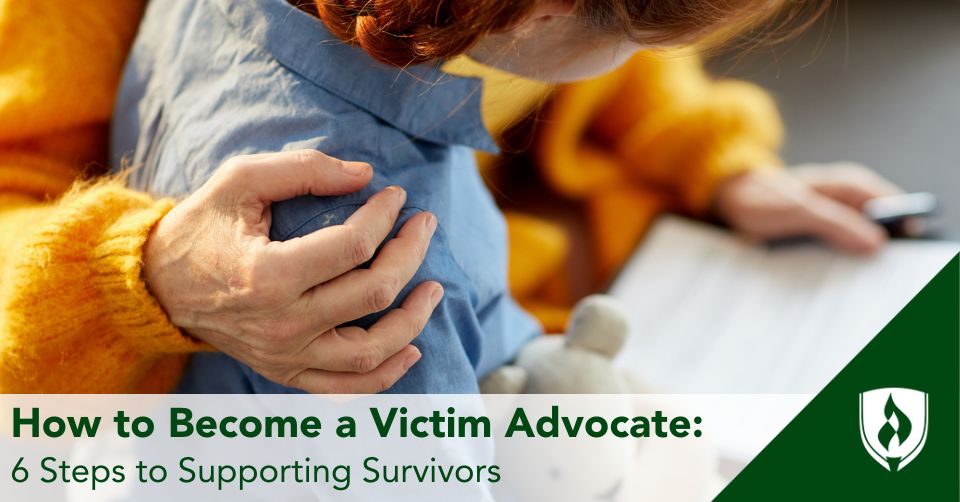
Victim advocates are individuals trained to support victims of crime. From emotional support to help finding resources, they provide a range of services that can differ from case to case—and all of them help show survivors they're not alone.1
If becoming a victim advocate is something you're interested in, you might be wondering where to start.
Here are six steps for how to become a victim advocate.
1. Learn more about what victim advocates do
The first step to pursuing any new career path is learning more about what that new role may entail, and using that information to confirm that it's the right choice for you. To get your research started, here's a little bit about what victim advocates do.
There are a lot of different ways that victim advocates offer their clients support. They may provide them with victims’ rights information, connect them with necessary resources and help them fill out crime victim related forms.1
Victim advocates will often be the point of contact for a victim throughout court proceedings, according to Colorado’s 4th Judicial District Attorney’s Office, as well as help answer questions about the court process, notify them of the most critical stages in the proceedings and provide them with updates on the status of their case.2
They may even accompany victims to court if requested, or appear virtually when needed. In addition to informing victims of their crime victims' rights,3 they may also help connect them with community resources, victim compensation resources and resources to implement or modify their protection orders.2
From emotional support to the legal process, victim advocates may work with a range of departments and agencies to support victims throughout the criminal justice process—before, during and after any court proceedings related to their cases.
Dig into this part carefully. Advocacy is not for everyone, and this field can be intense as you guide and listen to people who have often experienced violence or trauma.
2. Choose your ideal work setting
Victim advocates work in a variety of settings. Many victim service providers are nonprofit organizations, and a number of victim advocates work with criminal justice or social service agencies.1
Local, county and state governments may also have victim assistance programs that advocates can connect with victims through. In the U.S., victim advocacy programs continue up to the highest levels of government.
The Federal Bureau of Investigation (FBI) runs its own victim services program, and the U.S. Department of Justice runs the Office for Victims of Crime (OVC). While the FBI operates at the federal level, the OVC works collaboratively with each state to support crime victims as needed.
In addition to the different types of employers a victim advocate may work for, they may also work in a range of physical settings. Some victim advocates are on the move, physically accompanying victims to court or police stations. Others may take on more research-focused roles, working with agencies to help get important information to victims. Still other victim advocates work specifically for call centers or crisis hotlines and perform their work virtually.1
At the end of the day, the responsibilities of victim advocates will vary based not only the situations that their clients are facing, but the types of organizations they choose to work with and the settings they end up working in.1
3. Seek out your desired specialization
Not all victim advocacy organizations offer the same services, and not all victim advocates perform the same roles.
Some victim advocacy organizations serve victims across the nation—like the National Center for Victims of Crime® (NCVC)—while others may focus on victims in specific cities or states.
The NCVC is an example of an organization that serves victims of all types of crimes. If you think you're more interested in joining an advocacy group that provides specialized services for victims of specific types of crimes, you may find you have more options than you realized.
A few examples of victim advocate specialties include...
- Domestic violence victim advocacy
- Sexual assault victim advocacy
- Child abuse victim advocacy
- And more
In general, victim advocacy specializations tend to relate to the type of crime committed.
Domestic violence advocates may work for domestic violence hotlines, in domestic violence shelters or for nonprofits that provide certain resources for victims of violent crimes, and other specializations can offer a similar range of opportunities.
Not sure which specialization is for you? That's perfectly normal. Often, it's working in the field with different types of victims and other criminal justice professionals that can expose you to the various pathways out there—and spark an unexpected passion.
4. Consider further education in the field
Depending on the type of advocacy organization you'd like to work for—and whether it's local, nationwide and specialized in any way—education requirements will vary greatly. While there's no standard requirement from role to role, some employers may require or prefer candidates with a bachelor's degree.
One popular education track for aspiring victim advocates is a Bachelor’s degree in Criminal Justice. These programs help provide students with an understanding of how the justice system works, allowing victim advocates to better assist their clients throughout the process.
Courses on topics like cultural diversity and justice, values-based leadership in criminal justice and mental health and substance abuse in criminal justice can help students build a better understanding of crime and its impacts—and better serve with compassion and integrity.
Check with future employers regarding any credentials or work experience you’d need to obtain a position as a victim advocate.
5. Find a role in the criminal justice system
Once you've researched the career path and pursued any relevant education, it's time to secure a role. The good news is that the greater field is growing. Victim advocates are generally understood to fall under the umbrella of social and human service assistants jobs, since they help clients find the community services they need.4
The employment of social and human services assistants is projected to grow 8% from 2023 to 2033, according to the U.S. Bureau of Labor Statistics (BLS), which is faster than the average for all occupations. An average of 48,400 job openings for social and human service assistants are projected each year, over the decade.4
When it comes to questions of victim advocate salary, the specifics can vary greatly depending on the specific position, role, employer and location—so it's best to do your own research. Finding a role that aligns with your interests and goals as a victim advocate is an exciting step.
6. Choosing between criminal justice or human services
There's no question: crime victims advocate work is important. Navigating the legal system can be an overwhelming task for even the most prepared individuals, and nobody should have to face the process alone.
Whether you’ve experienced (or known someone who’s experienced) violent crime—or if you just have a strong sense of justice and the people most impacted by a crime, work as a victim advocate is definitely a job with a powerful impact.
And caring about victim advocacy means you probably already have the passion it takes.
Check out Should I Be a Criminal Justice Major? Everything You Need to Know to Decide to see if these programs would be a good fit for you.
National Center for Victims of Crime® is a registered trademark of National Center for Victims of Crime
1Victim Support Services, What is a Victim Advocate?, [Accessed December 2024] https://victimsupportservices.org/help-for-victims/what-is-a-victim-advocate/
2Colorado's 4th Judicial District Attorney's Office, Victim Advocate Role, [Accessed December 2024] https://www.da4colorado.gov/victim-advocacy
3Offices of the United States Attorneys, U.S. Department of Justice, Crime Victims' Rights Act, [Accessed December 2024] https://www.justice.gov/usao/resources/crime-victims-rights-ombudsman/victims-rights-act
4Bureau of Labor Statistics, U.S. Department of Labor, Occupational Outlook Handbook, Social and Human Services Assistants, (Accessed December 2024), U.S. Bureau of Labor Statistics. Employment conditions in your area may vary.




